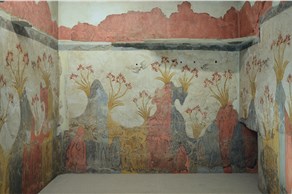One of the most important museums of Greece is the spectacular Museum of Prehistoric Thera that lies in the capital of Santorini, Fira. It is housed in a state-of-the-art, two-story building whose erection started in the beginning of the 1970s and it was finally offered to the public in 2000. The proponent of this museum was the standout Greek archeologist, Professor Spyridon Marinatos, who led the excavation works in the archaeological site of Akrotiri and prompted the creation of a museum in order to house the valuable finds from this major urban center that came to light, where a prominent regional civilization of the prehistoric world used to thrive during the Minoan Bronze Age.
The finds that are on display on the Prehistoric Museum of Thera come from the various excavations that were carried out on the island, such as at the settlements of Akrotiri and Potamos, rescue excavations at different sites on the island as well as some objects that were discovered by chance or handed over. The exhibits date back to the Late Neolithic Era up until the Cycladic Periods and are in excellent condition. Through the exhibits visitors can witness the progress of Thera in the Prehistoric Times unfolding before their eyes, as they bear testament to a brilliant course that made Thera on of the most significant islands of the Aegean during the 18th and 17th centuries BC.
Visitors to the museum, which is open daily (except Tuesdays in winter), can admire temporary exhibitions on the ground floor and four permanent exhibitions on the first floor. The first unit of them refers to the history of research at Thera, the second to the geology of the island, the third to the island’s history from the Late Neolithic to the Late Cycladic I Period and the last one to the heyday of the city at Akrotiri (mature Late Cycladic I Period, 17th century BC).
The Prehistoric Thera Museum can be considered an extension of the archaeological site of Akrotiri, where visitors can walk through the amazing, well-preserved prehistoric city, since it hosts many artifacts from there and, most importantly, the frescoes, the impressive mural paintings. These were found in both public and private edifices of Akrotiri and constitute one of the most incredible exhibits of the museum. They are colorful representations of nature and everyday life and give a valuable insight into the way of life back then and the environment. Among the items, there are also tools, utensils, marble figurines, pottery and some jewelry, since the inhabitants must have taken their precious objects with them when they left the island due to the looming volcanic eruption.
The rest of the collections, which are ordered chronologically, include Neolithic, Early and Middle Cycladic pottery, Early Cycladic metal artifacts and marble figurines which are numbered among the earliest pieces of the museum, as well as ancient items, like vases, ritual objects and bird jugs. Finally, the museum is in possession of fossils of bugs and plants that flourished before the human presence on Thera, including palm trees, olive leaves and schinus.
